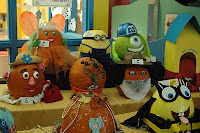Take time to play during daily routines. Watching apes play during a recent trip to the zoo reminded me that even during the daily routines of sleeping and eating one can find time to play. During what appeared to be gorilla nap time, one gorilla decided it was time to play. He was doing flips and making ape noises while the three other gorillas were resting. When another gorilla came over to investigate what all the ruckus was about, he joined in the fun too! It looked like a game of hide-and-go-seek had started between the two playful apes. By the time I made it around their enclave, they were resting comfortably with the other gorillas.
Play requires time in order for ideas to take shape and flourish. Aspects of play may
 evolve and change, but the need for play remains constant. I keep a knobby, squishy ball at my desk. Although it's meant for infant/toddler sensory exploration, I bought it at the Museum's Explorer Store for back support since I spend endless hours on the computer. A surprise outcome, however, has been the use of it as a toy. I like to pick it up and toss it in the air a few times, especially when I need to think. Rest assured I'm back to work after a few minutes of play, but watch out; I may just toss it your way if you walk by my office.
evolve and change, but the need for play remains constant. I keep a knobby, squishy ball at my desk. Although it's meant for infant/toddler sensory exploration, I bought it at the Museum's Explorer Store for back support since I spend endless hours on the computer. A surprise outcome, however, has been the use of it as a toy. I like to pick it up and toss it in the air a few times, especially when I need to think. Rest assured I'm back to work after a few minutes of play, but watch out; I may just toss it your way if you walk by my office.Where do you play? The play environment has to provide a sense of safety and security for one to freely explore. After that, the play possibilities are endless. Play time is not a break from learning; it is learning in action! Play environments should provide tools for further investigation and exploration of things that interest us. During play children explore, probe, experiment, investigate and inquire. Their play is often characterized by concentration and unwillingness to be distracted (Kieff, J., & Casbergue, R. (2000) Playful Learning and Teaching. Boston: Allyn and Bacon).
Watch this little boy's exploration as he plays in our Room for Rhythm, located in Creativity Connections Neighborhood. His concentration and investigations show learning in action!
To order one of the books suggested in this post, click here for on-line ordering through our website. Read a synopsis of Gordon Burghardt's research here. Watch various animals at play and read a more detailed article in the October issue of The Scientist here.
Be sure and take time to play!
























